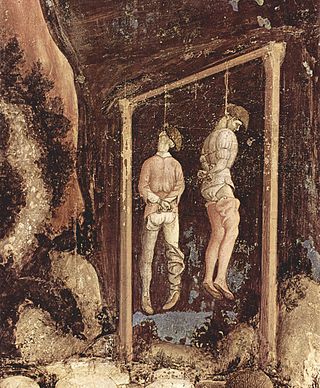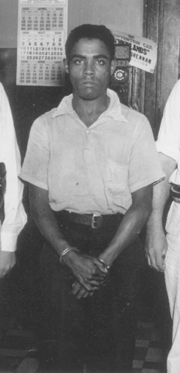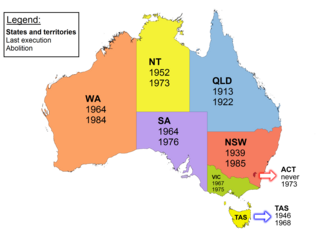Related Research Articles

Hanging is killing a person by suspending them from the neck with a noose or ligature. Hanging has been a common method of capital punishment since the Middle Ages, and is the primary execution method in numerous countries and regions. The first known account of execution by hanging is in Homer's Odyssey. Hanging is also a method of suicide.

Albert Pierrepoint was an English hangman who executed between 435 and 600 people in a 25-year career that ended in 1956. His father Henry and uncle Thomas were official hangmen before him.

Capital punishment in the United Kingdom predates the formation of the UK, having been used within the British Isles from ancient times until the second half of the 20th century. The last executions in the United Kingdom were by hanging, and took place in 1964; capital punishment for murder was suspended in 1965 and finally abolished in 1969. Although unused, the death penalty remained a legally defined punishment for certain offences such as treason until it was completely abolished in 1998; the last execution for treason took place in 1946. In 2004 the 13th Protocol to the European Convention on Human Rights became binding on the United Kingdom; it prohibits the restoration of the death penalty as long as the UK is a party to the convention.
Capital punishment in Canada dates back to Canada's earliest history, including its period as a French colony and, after 1763, its time as a British colony. From 1867 to the elimination of the death penalty for murder on July 26, 1976, 1,481 people had been sentenced to death, and 710 had been executed. Of those executed, 697 were men and 13 were women. The only method used in Canada for capital punishment of civilians after the end of the French regime was hanging. The last execution in Canada was the double hanging of Arthur Lucas and Ronald Turpin on December 11, 1962, at Toronto's Don Jail. The military prescribed firing squad as the method of execution until 1999, although no military executions had been carried out since 1946.
Capital punishment is a legal penalty in the U.S. state of New Hampshire for persons convicted of capital murder prior to 30 May 2019, when it was abolished prospectively for future crimes.

Capital punishment in New Zealand – the process of sentencing convicted offenders to death for the most serious crimes and carrying out that sentence, as ordered by a legal system – first appeared in a codified form when New Zealand became a British colony in 1840. It was first carried out with a public hanging in Victoria Street, Auckland in 1842, while the last execution occurred in 1957 at Mount Eden Prison, also in Auckland. In total, 85 people have been executed in New Zealand.

HM Prison Manchester is a Category A and B men's prison in Manchester, England, operated by His Majesty's Prison Service. It is still commonly referred to as Strangeways, which was its former official name derived from the area in which it is located, until it was rebuilt following a major riot in 1990.

Rainey Bethea, was the last person publicly executed in the United States. Bethea, who confessed to the rape and killing of a 70-year-old woman named Lischia Edwards, was convicted of her rape and publicly hanged in Owensboro, Kentucky. Mistakes in performing the hanging, and the surrounding media circus, contributed to the end of public executions in the United States.

The use of capital punishment by the United States military is a legal punishment in martial criminal justice. Despite its legality, capital punishment has not been imposed by the U.S. military in over sixty years.
Capital punishment is a legal penalty in Sri Lanka.
Capital punishment is a legal punishment in Iran. Crimes punishable by death include murder; rape; child molestation; homosexuality; pedophilia; drug trafficking; armed robbery; kidnapping; terrorism; burglary; incestuous relationships; fornication; prohibited sexual relations; sodomy; sexual misconduct; prostitution; plotting to overthrow the Islamic regime; political dissidence; sabotage; arson; rebellion; apostasy; adultery; blasphemy; extortion; counterfeiting; smuggling; speculating; disrupting production; recidivist consumption of alcohol; producing or preparing food, drink, cosmetics, or sanitary items that lead to death when consumed or used; producing and publishing pornography; using pornographic materials to solicit sex; recidivist false accusation of capital sexual offenses causing execution of an innocent person; recidivist theft; certain military offenses ; "waging war against God"; "spreading corruption on Earth"; espionage; and treason. Iran carried out at least 977 executions in 2015, at least 567 executions in 2016, and at least 507 executions in 2017. In 2018 there were at least 249 executions, at least 273 in 2019, at least 246 in 2020, at least 290 in 2021, at least 553 in 2022, and at least 309 so far in 2023.

Capital punishment in Australia was a form of punishment in Australia that has been abolished in all jurisdictions. Queensland abolished the death penalty in 1922. Tasmania did the same in 1968. The Commonwealth abolished the death penalty in 1973, with application also in the Australian Capital Territory and the Northern Territory. Victoria did so in 1975, South Australia in 1976, and Western Australia in 1984. New South Wales abolished the death penalty for murder in 1955, and for all crimes in 1985. In 2010, the Commonwealth Parliament passed legislation prohibiting the re-establishment of capital punishment by any state or territory. Australian law prohibits the extradition or deportation of a prisoner to another jurisdiction if they could be sentenced to death for any crime.

William Calcraft was a 19th-century English hangman, one of the most prolific of British executioners. It is estimated in his 45-year career he carried out 450 executions. A cobbler by trade, Calcraft was initially recruited to flog juvenile offenders held in Newgate Prison. While selling meat pies on streets around the prison, Calcraft met the City of London's hangman, John Foxton.
Capital punishment in Afghanistan is legal and could be carried out secretly or publicly. The convict could be hanged or shot to death. Stoning, amputation, and flogging were also sometimes used as a method for punishment, especially during the late 1990s. Public executions have existed throughout Afghanistan's history. They have continued with the Taliban returning to power in August 2021. Some executions were recently condemned by the United Nations. The capital offenses generally include heinous crimes such as mass murders and are governed by Sharia, along with civil laws.
Hanging has been practiced legally in the United States of America from before the nation's birth, up to 1972 when the United States Supreme Court found capital punishment to be in violation of the Eighth Amendment to the United States Constitution. Four years later, the Supreme Court overturned its previous ruling, and in 1976, capital punishment was again legalized in the United States. As of 2021, three states have laws that specify hanging as an available secondary method of execution.
Capital punishment is a legal penalty in Jordan. The country had a moratorium on capital punishment between 2006 and 2014. In late 2014 the moratorium was lifted and 11 persons were executed. Two more executions followed in 2015, 15 executions took place in 2017 and one in 2021.
Capital punishment has never been practiced Alaska throughout its history as a state, as it was abolished in 1957. Between December 28, 1869, and April 14, 1950, between the Department, District, and Territory of Alaska, twelve felons, all male, were executed by hanging for murder, robbery, and other crimes. Some were European, some were Native American, and two were African. The territorial legislature abolished capital punishment in 1957 during preparations for statehood, making Alaska the first in the West Coast of the United States to outlaw executions, along with Hawaii, which did the same.

Daryl Linnie Mack was an American man who was executed in Nevada for murder. Mack was sentenced to death for the October 1988 rape and murder of Betty Jane May in Reno. The murder went unsolved for twelve years until DNA evidence linked him to the crime. He was already in jail at the time, having been sentenced to life in prison without parole for the April 1994 murder of Kim Parks. He was sentenced to death, waived his appeals and asked to be put to death. Mack was executed via lethal injection at Nevada State Prison on April 26, 2006. He remains the last person executed in Nevada.
Mary Timney was the last woman publicly executed in Scotland. She had been convicted of the murder of her landlady Ann Hannah.
References
- ↑ "New Dumfries History Tour Marks Scotland's Last Public Hanging". Dumfries & Galloway! What's Going On?. 10 May 2018. Retrieved 30 March 2022.
- 1 2 "1868: Robert Smith, the last publicly executed in Scotland". Executed Today.com. 12 May 2016. Retrieved 30 March 2022.
- ↑ "Dumfries: The site of Scotland's last public hanging". BBC News. 12 May 2018. Retrieved 30 March 2022.
- 1 2 "Mary Timney: the last woman publicly hanged in Scotland". BBC News. 27 April 2012.
- ↑ "The ending of public executions in the 19th century". Capital Punishment UK.